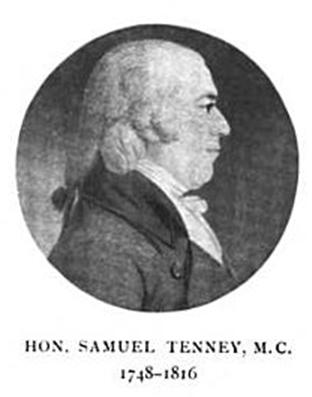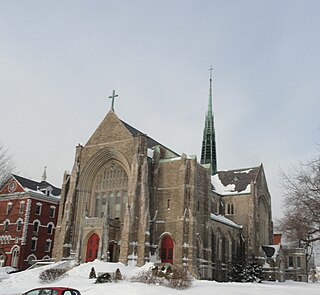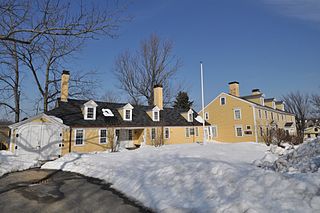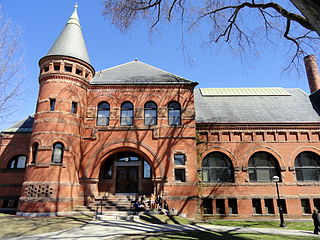
Exeter is a town in Rockingham County, New Hampshire, United States. Its population was 16,049 at the 2020 census, up from 14,306 at the 2010 census. Exeter was the county seat until 1997, when county offices were moved to neighboring Brentwood. Home to Phillips Exeter Academy, a private university-preparatory school, Exeter is situated where the Exeter River becomes the tidal Squamscott River.

Asher Benjamin was an American architect and author whose work transitioned between Federal architecture and the later Greek Revival architecture. His seven handbooks on design deeply influenced the look of cities and towns throughout New England until the Civil War. Builders also copied his plans in the Midwest and in the South.

Castle in the Clouds is a 16-room mansion and 5,294-acre (2,142 ha) mountaintop estate in Moultonborough, New Hampshire, opened seasonally to the public by the Castle Preservation Society. It overlooks Lake Winnipesaukee and the Ossipee Mountains from a rocky outcropping of Lee Mountain formerly known as "The Crow's Nest".

Samuel Tenney was a United States representative from New Hampshire. Born in Byfield in the Province of Massachusetts Bay, he attended Governor Dummer Academy and graduated from Harvard College in 1772. He taught school at Andover and studied medicine, beginning practice in Exeter, New Hampshire. He was a surgeon in the Revolutionary War. He tended the wounded patriots following the Battle of Bunker Hill then for the next year served as Surgeon's Mate alongside Massachusetts troops. For the balance of the war he was a surgeon attached primarily to the 1st Rhode Island Regiment. He was present at the surrenders of Burgoyne and Cornwallis; encamped at Valley Forge, Pennsylvania, during that fierce Winter 1777/78; was designated Acting Surgeon General of the Army upon general orders of General George Washington; and then returned to Exeter at the close of the war where he took up politics and other scholarly pursuits. He was a delegate to the State constitutional convention in 1788 and a judge of probate for Rockingham County from 1793 to 1800. He was secretary of the New Hampshire Medical Society and commissioned Paul Revere to produce the first engraving of that organization's seal. Used the pseudonym "Alfredus" to publish commentary as part of public debate over the design and ratification of the U.S. Constitution. He was elected a Fellow of the American Academy of Arts and Sciences in 1791, and was elected a member of the American Antiquarian Society in 1815.

Benjamin Pickman Jr. was a U.S. Representative from Massachusetts.

The Zimmerman House is a house museum in the North End neighborhood of Manchester, New Hampshire. Built in 1951, it is the first of two houses in New Hampshire designed by Frank Lloyd Wright, and one of a modest number of Wright designs in the northeastern United States. The house was built for Dr. Isadore Zimmerman and his wife Lucille. The house is now owned by the Currier Museum of Art because of the Zimmermans' decision to donate the home to the public after their death. The museum provides tours of the building, which is the only legal access to the grounds. It was listed on the National Register of Historic Places in 1979.

Timothy G. O’Connell (1868–1955) was an American architect whose Boston-based practice specialized in ecclesiastical design.

The American Independence Museum is a historic house museum located in Exeter, New Hampshire. Its 1-acre (0.40 ha) campus includes two buildings: the Ladd-Gilman House, a registered National Historic Landmark built in 1721 by Nathaniel Ladd, and the Folsom Tavern, listed on the New Hampshire State Register of Historic Places and built in 1775 by Colonel Samuel Folsom. The museum was opened in 1991 after a rare copy of the Declaration of Independence known as a Dunlap Broadside was found in the Ladd-Gilman house, 200 years after its arrival in Exeter. It is the centerpiece of the museum’s collection. The museum’s mission is “Connecting America’s Revolutionary past with the present.”

The Gilman Garrison House is a historic house museum at 12 Water Street in Exeter, New Hampshire. Built in 1709, it is a rare surviving example of a garrison house or fortified structure. It is owned by Historic New England, which operates the home as a house museum, and was listed on the National Register of Historic Places in 1976.

Lieut. Samuel Leavitt (1641–1707) was an early colonial American settler of Exeter, New Hampshire, one of the four original towns in the colony of New Hampshire, where Leavitt later served as a delegate to the General Court as well as Lieutenant in the New Hampshire Militia, and subsequently as member of the New Hampshire House of Representatives. The recipient of large grants of land in Rockingham County, Leavitt held positions of authority within the colonial province.

The Front Street Historic District in Exeter, New Hampshire, encompasses a portion of the town's historic center. The district extends from Swasey Pavilion, at the junction of Front and Water streets, southwesterly along Front Street to Gale Park, about five blocks. Front Street is one of Exeter's oldest roads, and is lined with a series of 18th and 19th-century civic, religious, and residential structures, many of which are well preserved. The district was listed on the National Register of Historic Places (NRHP) in 1973.

Samuel Joseph Follon Thayer (1842–1893) was an American architect, notable for designing buildings such as the Providence City Hall and the Cathedral of St. George, as well as the town halls of Brookline, Stoughton, and Methuen, Massachusetts. He was part of the architecture firms, Martin & Thayer and Ropes & Thayer.

Tabitha Gilman Tenney (1762–1837) was an early American author from Exeter, New Hampshire.
William Robinson Miller (1866–1929) was an American architect from Maine. He specialized in richly ornamented Romanesque- and French-Revival buildings. Born in Durham, Maine, Miller attended Bates College and the School of Architecture at the Massachusetts Institute of Technology (1891–1892).

The Dudley House, also known as the Perry-Dudley House, is a historic house at 14 Front Street in Exeter, New Hampshire. Built about 1805, it is a prominent local example of Federal architecture, further notable for its occupation by two of the town's leading 19th-century doctors. The house was listed on the National Register of Historic Places in 1971. It now houses professional offices.

The Exeter Waterfront Commercial Historic District encompasses the historic commercial and residential waterfront areas of Exeter, New Hampshire. The district extends along the north side of Water Street, roughly from Main Street to Front Street, and then along both sides of Water and High streets to the latter's junction with Portsmouth Street. It also includes properties on Chestnut Street on the north side of the Squamscott River. This area was where the early settlement of Exeter took place in 1638, and soon developed as a shipbuilding center. The district was listed on the National Register of Historic Places in 1980. It was enlarged in 1986 to include the mill complex of the Exeter Manufacturing Company on Chestnut Street.

The Maj. John Gilman House is a historic house at 25 Cass Street in Exeter, New Hampshire, United States. Built in 1738, it is a well-preserved example of a Georgian gambrel-roof house, further notable for its association with the locally prominent Gilman family. It was listed on the National Register of Historic Places in 1988.

The Congregational Church in Exeter is a parish of the United Church of Christ located on Front Street in Exeter, New Hampshire.

The Hawthorne Hotel is a historic hotel located on Washington Square West in Salem, Massachusetts. The hotel is named after novelist and Salem native Nathaniel Hawthorne. Built in 1925, the hotel is currently a member of the Historic Hotels of America, the official program of the National Trust for Historic Preservation. The U.S. News & World Report ranked it the number one hotel in Salem. It has also been listed as one of the top allegedly haunted places in Massachusetts and the country.

Rufus Sargent (1812-1886) was an American architect practicing in Newburyport, Massachusetts during the nineteenth century.






















